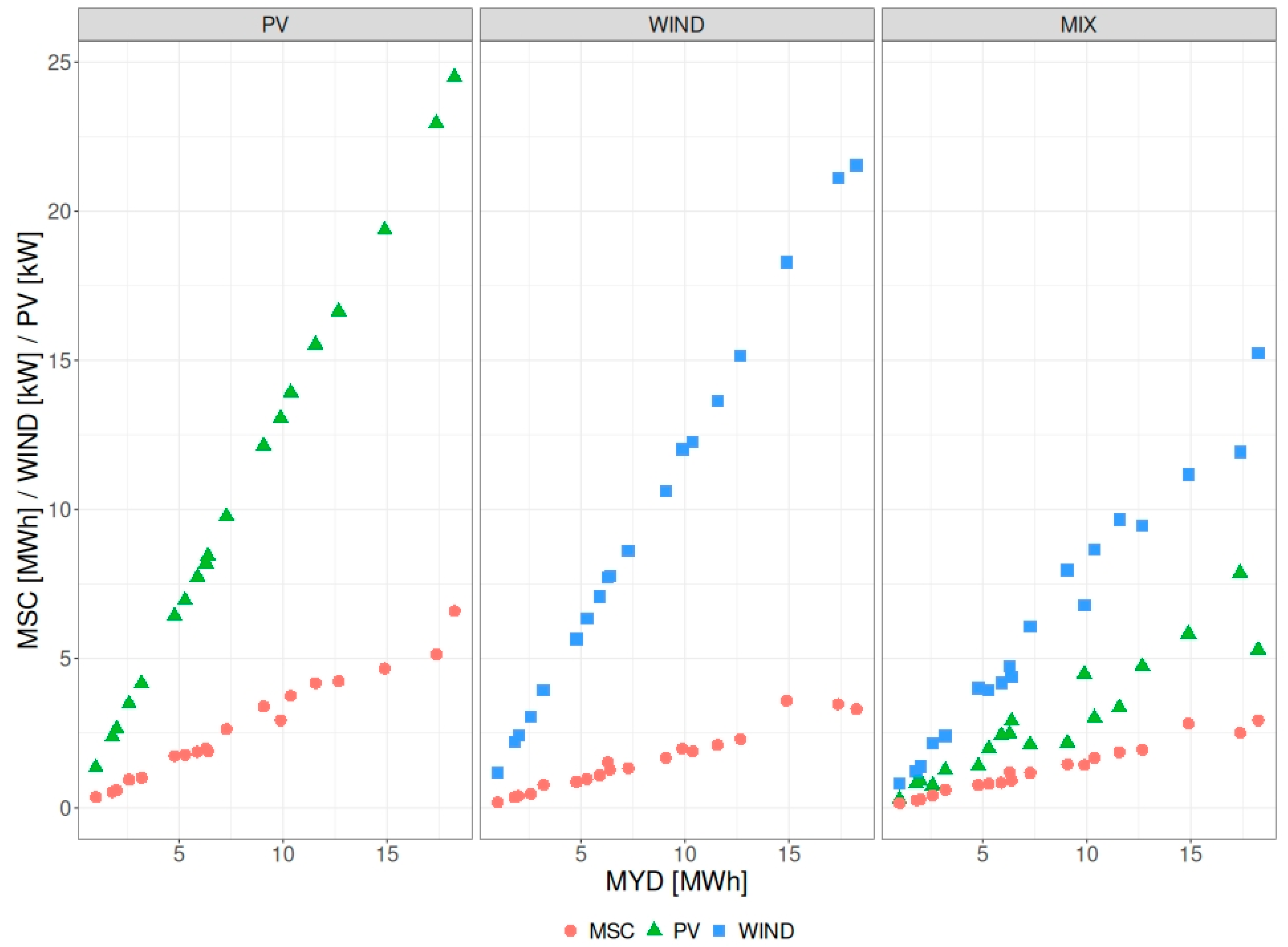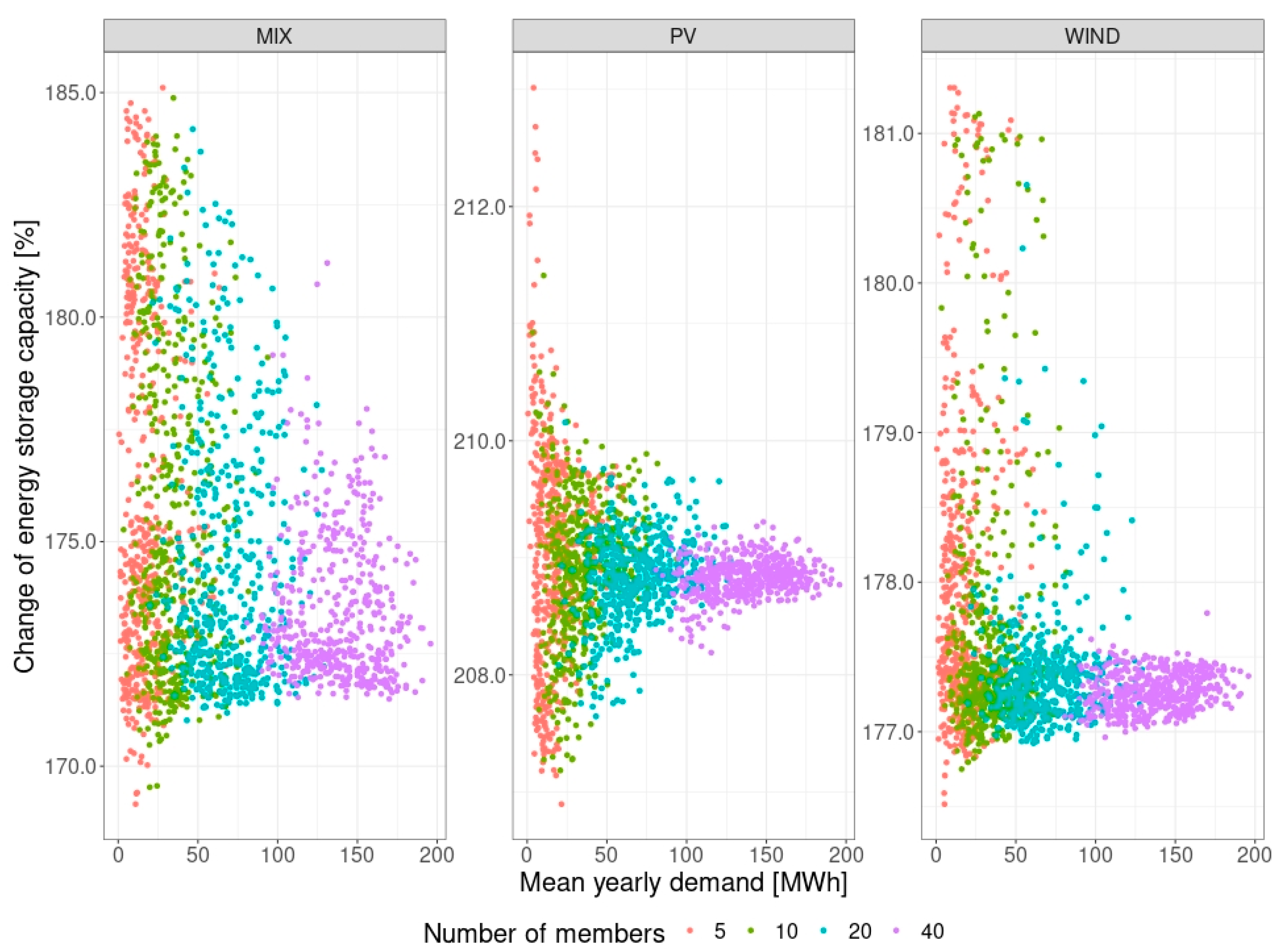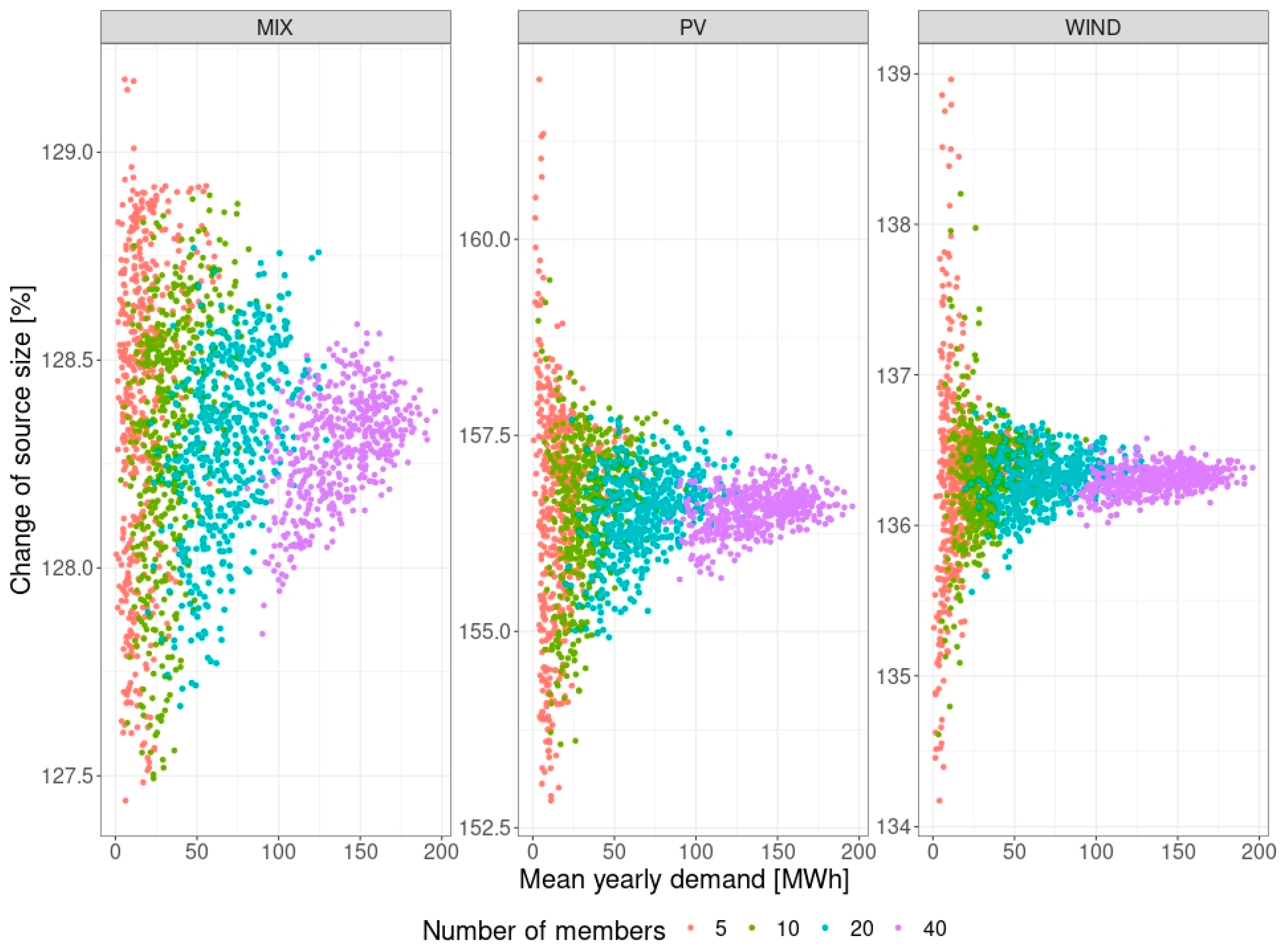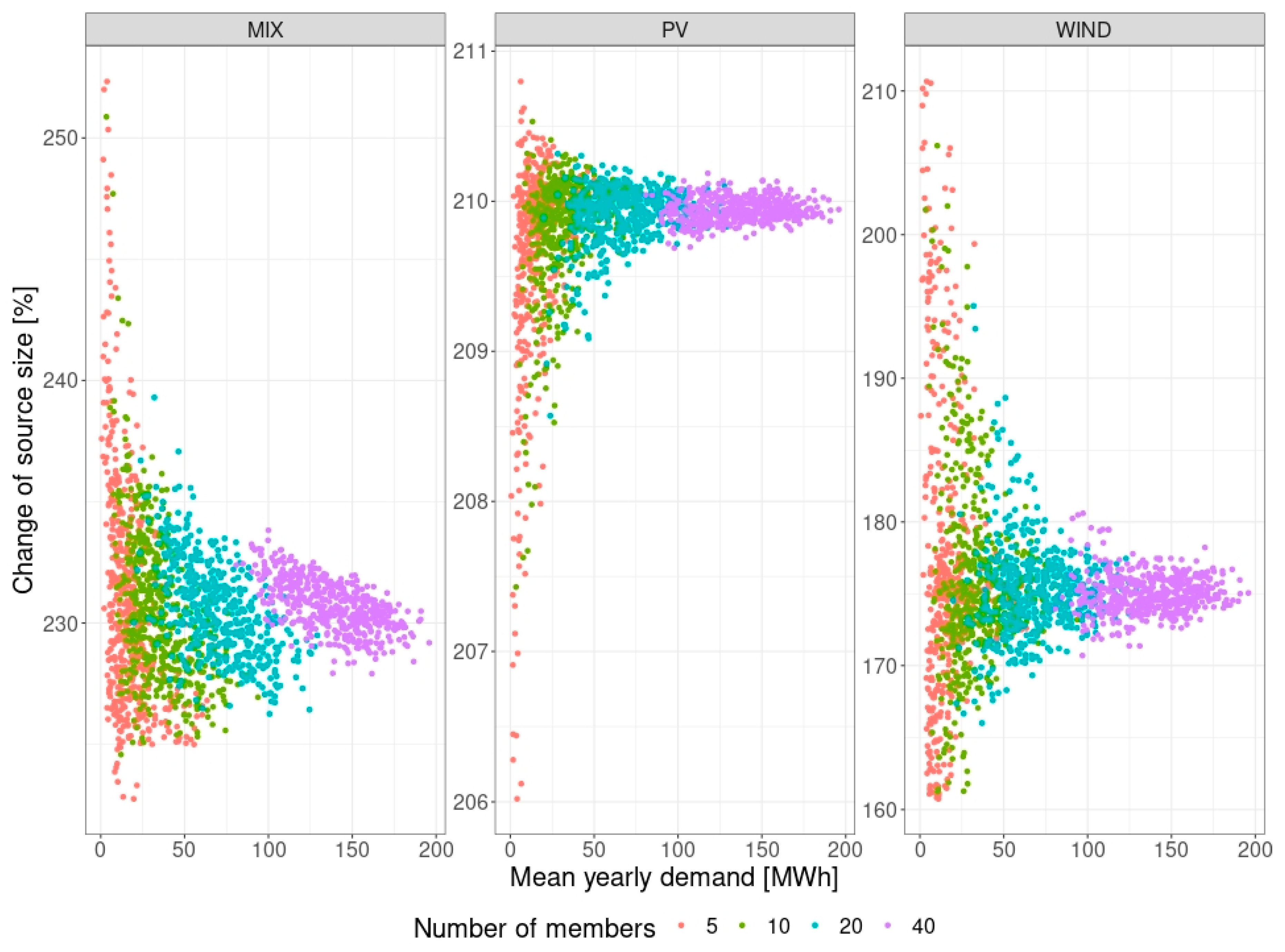1. Introduction
Hydrogen storages are an important element of the European hydrogen strategy [
1], the renewable energy market [
2], and the development of self-sufficiency of local energy communities [
3]—Renewable Energy Community [
4] and Citizens Energy Community [
5]—and so they are strongly promoted in the strategic documents on the development of the energy market in the EU [
6,
7]. Hydrogen, along with the increasing share of renewable energy sources [
8]—(in May 2022, as part of the “RePowerEU” plan following the Russian aggression against Ukraine, the Commission proposed a new amendment (RED III) to accelerate the transition to clean energy in line with the gradual reduction of dependence on Russian fossil fuels. The European Commission proposed installing heat pumps, increasing the capacity of photovoltaic systems, and importing renewable hydrogen and biomethane to increase the 2030 renewable energy target to 45%)—and the increasingly efficient use of resources in a circular economy [
9], are expected to play an important role in the integrated European energy system of the future, becoming a technology that can really compete with lithium-ion storage [
10]. Traditional energy storage technologies are described in a valuable and synthetic way in the scientific literature [
11], which, together with their application areas, thus provide an interesting reference base for hydrogen technology applications. The European Hydrogen Strategy anticipates that hydrogen will solve many of the problems with energy storage for balancing the variable supply of renewable energy sources (RES) and the variable demand for RES-generated energy [
12]. It will also become a catalyst for change in broadly defined urban spaces, including in transportation [
13,
14]. Starting to use clean hydrogen (according to the European Commission, “clean hydrogen” refers to hydrogen produced by the electrolysis of water with electricity originating from renewable sources. It can also be produced by biogas reforming or by biochemical conversion of biomass, assuming that the sustainability requirements are met) on a wide scale and at a rapid pace is crucial for the EU to achieve its very ambitious climate target of cost-effective greenhouse-gas emission reduction of at least 50–55% by 2030 [
1,
15]. In the strategy papers concerning achieving climate neutrality, the EU assumes an increase in the share of hydrogen in the European energy mix from the present 2% to 13–14% [
6].
However, there is still no guarantee that the EU’s hydrogen production potential can be fully harnessed [
16]. At today’s stage of technology development, it is important to be aware of the many barriers and problems that are inherent in the issue of the popularization and use of hydrogen fuel and hydrogen storage [
17]. These include:
choosing the right research pathways into the use of wind-based, solar-based, or grid-electricity-based electrolysis, or perhaps the use of steam-methane reforming [
18];
focusing on the development of the most efficient technology and source of hydrogen, i.e., producing hydrogen from natural gas, renewable sources or nuclear energy [
19];
cost issues and cost dependencies: the cost of renewable hydrogen and the effect of storage on hydrogen production [
20];
institutional problems: delayed legislation, the lack of standards and certification schemes;
the adequate availability of financial and investment instruments from the public (e.g., EU funds) as well as private (banks, VCs);
last but not least, the “chicken and egg” problem, meaning supply is waiting for demand to develop and vice versa [
16].
Hydrogen storage is a means for storing compressed or liquid hydrogen that can later be used as an energy carrier. Although the use of hydrogen for energy storage is not yet common due to the high costs and energy losses associated with it (currently estimated at about 60% in the so-called “full cycle”) [
21,
22], the development of hydrogen technologies as well as the gradual introduction of instruments reducing the cost of production and use of renewable hydrogen [
23] are one of the key challenges of the emerging EU-level legislation on energy production and improving Europe’s energy neutrality [
8,
24]. With the development of hydrogen storage technologies, we can expect that the cost of building hydrogen storages and their operation will gradually decrease [
25], which will contribute to the further development of the RES market; so we will experience a kind of feedback where hydrogen technologies will drive the development of the RES sector, while the further development of the RES sector will support the work on greater efficiency and lower costs of using hydrogen-storage technologies [
26]. The implementation of large-scale solutions [
27] and the introduction of newer and newer technologies that allow home storage of RES energy in hydrogen storages [
28,
29] are already being considered today, not only in terms of entire estates or apartment blocks, but also individual households [
30].
The support for the EU hydrogen-strategy implementation and the planned investments in strategic areas for achieving the Green Deal [
31] is to be provided by the European Clean Hydrogen Alliance [
32], which brings together representatives of industry, civil society, administrations at various levels, and the European Investment Bank (EIB). The Alliance’s activities to identify key and feasible investment projects for creating a hydrogen market in the EU were inaugurated by the European Commission in 2020. The European Commission is already supporting the implementation of hydrogen-related projects through the EU’s financial instruments, including InvestEU within the framework of the Next Generation EU [
33].
The hydrogen economy is expected to be an opportunity to strengthen the EU, as it could directly provide up to a million emerging jobs by 2030 and 5.4 million jobs by 2050 [
34]. The US administration is also hoping for job growth based on the development of the hydrogen market [
35]. The development of hydrogen technology may also represent an opportunity for regions that are currently heavily dependent on conventional energy sources and will be at the risk of poverty once fossil fuels are phased out; renewable hydrogen’s potential to generate jobs is estimated at 10,300 jobs for every billion euros invested [
36].
At the same time, various forms of the energy communities are developing in EU countries. In Poland, but also in some other EU countries like Germany, Italy or Denmark [
37], they have taken the form of energy cooperatives. These are institutions that enable groups of people or entities to make investments, manage and benefit from joint ownership of RES energy plants and infrastructure, particularly such as photovoltaic panels or wind turbines. The idea behind energy cooperatives is to increase their members’ energy independence from large energy corporations (energy producers or distributors) and to increase the share of renewable sources in energy production and distribution. Today, energy cooperatives are still a small segment of the energy market, but their development is promising. In Germany [
38] or Denmark [
39], energy cooperatives are already very popular and successfully compete on the market. Also in Poland, an increasing number of such local energy communities [
40] and social networks [
41] are being established; currently more than ten energy cooperatives are waiting to be registered with the court and entered in the register, with a further several dozen in the pipeline. Previous research work and papers published by the authors show that integrating individual prosumers into an energy cooperative established under the terms set out in Polish law cannot only be profitable [
40], but may meet the new challenges of energy communities, such as support for prosumers also in the light of the COVID-19 effect [
42], meeting the requirements of the capacity market [
43] or even in the much-needed process of crypto-coin “greening” [
44].
As the EU will certainly not deviate from the path of developing and supporting the use of hydrogen, and will foster the emergence of local self-sufficient energy communities, we should already consider whether it is viable to combine innovative technological solutions (hydrogen storages) and new institutional solutions for RES (energy cooperatives). In this paper, the authors reflect on the following:
Is it possible for an energy cooperative to achieve full or partial energy independence using its own RES and hydrogen storage?
What must be the minimum aggregate capacity of RES held by members of an energy cooperative so that, with the use of a hydrogen storage with certain parameters, it is possible not to exchange electricity with the grid?
Is it possible to reduce the capacity of a hydrogen storage operating within a cooperative by oversizing the RES held by members of an energy cooperative? If so, what relationship exists in this case between the scale of such oversized sources and the size of the hydrogen storage?
All models of cooperatives proposed and studied in this paper as well as the data on energy production and consumption on farms that are members of a cooperative are based on anonymized actual data obtained from energy consumers and producers living in Polish rural areas.
Our research, which is based on real data, allowed us to create several model energy cooperatives taking into account the legal conditions of forming and developing these institutions, while incorporating an innovative element in the form of hydrogen storage. Second, our paper also fills a literature gap and in a methodological gap, as the methodological approach presented here can easily be applied to other distributed-energy institutions that are and will be established in Europe and other continents. Third, it is novel at the European level as it investigates the problem that has only been partially analyzed with respect to EU countries, i.e., there has been no combined analysis on the formation of energy communities with the use of a hydrogen storage.
An extensive analysis of the literature on the subject indicates an important publication gap, which the authors of this paper seek to fill. Known research and publications in the subject do not link the unique topic of energy storage in the form of green hydrogen within energy communities. Hydrogen storage in itself is so far not very popular, and in combination with “prosumerism” and the development of energy communities it represents a pioneering approach and a non-trivial proposal for building local energy independence. The contribution of the paper to scientific literature lies in proving that: (i) the storage of green hydrogen for later conversion to electricity may also be applicable at the local level; (ii) there is a relationship between the capacity of a hydrogen storage and the capacity of RES that allows for building full energy independence; (iii) the type of RES generating source is important in optimizing the capacity of a hydrogen storage.
The paper is structured as follows. The second section presents and describes the requirements for the formation and operation of energy cooperatives. The section also presents the characteristics of dozens of prosumers (meaning simultaneous consumers and producers of energy), living in rural areas in southern and central Poland, who form the energy cooperatives analyzed in the paper. We also discuss the method of selecting 2000 random energy cooperatives that are also analyzed. We present the key assumptions for the simulations carried out.
Section 3 (Materials and Methods) describes the research material, i.e., a sample of energy cooperatives properly selected for simulation purposes, and briefly presents the optimization models used in the research. The subsequent section includes the results of our analyses that are discussed case by case. At the end, we draw conclusions that made it possible to conclude the entire work and research, and indicate the limitations and possible future directions of the authors’ research work to explore the issue presented in this paper.
4. Results and Discussion
The above shape of energy cooperatives EC1–EC4 underwent nine types of simulation using:
breakdown by source type (PV, WIND, MIX),
different variants of the cooperative:
- o
CASE_0: a conventional cooperative connected to a grid and using a virtual network storage in the discount model,
- o
CASE_1A: a cooperative with a hydrogen storage with the minimum capacities of generating sources,
- o
CASE_1B: a cooperative with a hydrogen storage with the minimum storage capacity.
Table 3 shows scenarios for the optimal selection of source capacity and storage capacity for each variant of cooperative EC1. A visualization of the data contained in
Table 3 can be found in
Figure 2 (below the table).
The results obtained by simulation and presented in
Table 3 can be interpreted as follows:
CASE_0: When PV modules were the only type of source used, the conventional cooperative had a total installed capacity of 44.288 kW and the maximum accumulated surplus electricity (accumulated in the operator’s grid) reached 11.759 MWh.
CASE_1A: When a virtual (grid) storage was replaced with a hydrogen storage, the calculation was based on the power-to-power chain [
59] with a final efficiency of 29% and on the assumption that the cooperative seeks to minimize the capacity of the sources while meeting the condition of energy self-sufficiency [
60]. Then the total installed PV capacity will be 69.873 kW, and the maximum filling in the hydrogen storage will reach 26.77 MWh.
CASE_1B: Energy independence of a cooperative is achieved while meeting the criterion of minimum hydrogen storage capacity. In this case, the capacity of the installed PV sources is 92.016 kW, and the storage capacity will reach 19.019 MWh.
An analysis of the results leads to the following conclusions:
From the perspective of the cooperative’s energy balance, it is possible to achieve energy independence by replacing the virtual energy storage in the distribution network by a hydrogen storage fitted with an electrolyzer. This requires oversizing the capacity of the generating source and the storage. For the scenario analyzed based on PV sources, we need to increase the power capacity (CASE_1A/CASE_0) from 44.288 kW to 69.873 kW (by 58%) and storage capacity from 11.759 MWh to 26.77 MWh (by 128%). The need to oversize the capacity of the sources and the storage capacity was also confirmed through simulation carried out at the level of cooperatives of different sizes and random participants. The relationship of the change of energy storage capacity [%] as a function of mean yearly demand [MWh] for CASE_1A vs. CASE_0 is shown in
Figure 3 along with the quantiles shown in
Table 4. A single point in
Figure 1 is the result of one computing session. Depending on the type of generating source and the size of cooperative, we can observe different levels of concentration and symmetry of results, and the higher the number of members within a single cooperative, the greater the symmetry and level of concentration of results. For instance, for a scenario with PV sources and 40 cooperative members, the criterion specified in CASE_1A is satisfied when storage capacity is increased by around 209% on average.
The simulation also determined the characteristics of the change of source size [%] as a function of mean yearly demand [MWh], for CASE_1A vs. CASE_0, which is shown in
Figure 4, while the quantiles of the distribution are shown in
Table 5. We should point out that the higher the number of cooperative members, the greater the concentration and symmetry of results. For instance, for a scenario with PV sources and 40 cooperative members, the criterion specified in CASE_1A is satisfied when the capacity of the generating source is increased by around 56% on average.
for the PV scenario, meeting the criterion defined in CASE_1B relative to the baseline (CASE_0) requires an increase in the source capacity from 46.904 kW to 96.169 kW (by 105%), which is also linked to a 92% increase in storage capacity from 16.16 MWh (virtual grid storage) to 30.984 MWh (hydrogen storage). In order to confirm the relationship and examine it at a general level, a simulation was carried out for energy cooperatives of different sizes with a random selection of participants. The analysis of the results, including the relationship of the change of energy storage capacity [%] as a function of mean yearly demand [MWh] for CASE_1B vs. CASE_0, is shown in
Figure 5 along with the distribution of quantiles shown in
Table 6. The results confirm that different degrees of concentration and symmetry were achieved depending on the number of participants, and that the result show clear disproportions depending on the type of generating source. An increase in storage capacity is evident for the scenario with PV sources, where it is around 152% on average for a cooperative with 40 members. We should emphasize that if we compare these values to the results for scenarios with wind and hybrid sources, respectively, the results will be more than two times and six times lower. For a 40 members’ cooperative with a mix of generating sources, the capacity reduction is around 75%, or around 35–40% if only wind sources are used.
Figure 5.
A change in storage capacity as a function of average energy demand for CASE_1B vs. CASE_0.
Figure 5.
A change in storage capacity as a function of average energy demand for CASE_1B vs. CASE_0.
Table 6.
Quantiles of distribution—the relationship of the change of energy storage capacity [%] as a function of mean yearly demand [MWh] for CASE_1B vs. CASE_0.
Table 6.
Quantiles of distribution—the relationship of the change of energy storage capacity [%] as a function of mean yearly demand [MWh] for CASE_1B vs. CASE_0.
| src\Quantile | q.0% | q.10% | q.20% | q.30% | q.40% | q.50% | q.60% | q.70% | q.80% | q.90% | q.100% |
|---|
| mix | 19.72 | 23.98 | 24.90 | 25.39 | 25.75 | 26.06 | 26.39 | 26.76 | 27.24 | 28.06 | 44.62 |
| pv | 147.69 | 149.29 | 149.78 | 150.22 | 150.54 | 150.85 | 151.20 | 151.67 | 152.41 | 153.90 | 169.77 |
| wind | 34.92 | 56.30 | 58.21 | 60.42 | 62.59 | 64.06 | 65.34 | 66.86 | 68.47 | 70.90 | 81.46 |
The results presented are complemented by the change of source size [%] as a function of mean yearly demand [MWh], for CASE_1A vs. CASE_0, which is shown in
Figure 6, while the quantiles of the distribution are shown in
Table 7. Regardless of the type of generating source used, satisfying the CASE_1A criterion requires a significant increase in its capacity. For a cooperative of 40 members, the percentage change in source capacity for the mix, PV, and wind scenarios is 230%, 210%, and 175%, respectively.
Increasing the capacity of a generating source (CASE 1B/CASE1A) effectively reduces the hydrogen storage capacity regardless of the type of source (PV/WIND). For the variant with PV sources, a reduction in hydrogen storage capacity from 26.77 MWh to 19.019 MWh (by 29%) is possible if we increase the source capacity from 69.873 kW to 92.016 kW (by 32%). Similar calculations for the variant with wind sources indicate that it is possible to reduce the storage capacity from 12.713 MWh to 2.89 MWh (by 77%) thanks to oversizing the source capacity from 53.238 kW to 81.005 kW (by 52%). For the hybrid scenario combining both generation technologies, a reduction in storage capacity from 12.101 MWh to 1.326 MWh (by 89%) becomes possible if we increase the total capacity from 47.751 kW to 91.565 kW (by 92%).
The results obtained for cooperatives EC2–EC4 are presented in a similar manner in
Table 8.
The results of the analyses for other structures of cooperatives EC2–EC4 allow us to draw conclusions directionally consistent with those for EC1. The technical feasibility, for any scenario and type of a generating source, to substitute a grid storage with a physical hydrogen storage is confirmed. The most beneficial generation-storage structure considering the balance of source capacity and storage capacity occurs in the MIX scenario, which assumes the presence of both types of generating source. For the case that assumes minimizing the storage capacity, it is necessary to increase the total capacity of the sources around twice to be able to obtain around a four-fold reduction in storage capacity.














